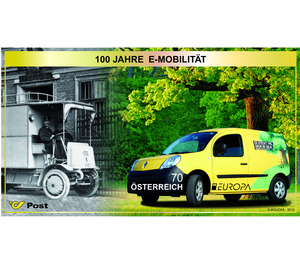100 years - Austria / II. Republic of Austria 2013 - 70 Euro Cent
Theme: Traffic, Transportation & Mobility
| Country | Austria / II. Republic of Austria |
| Issue Date | 2013 |
| Face Value | 70.00 |
| Edition Issued | 170,000 |
| Printing Type | offset |
| Stamp Type | Commemorative |
| Item Type | Stamp |
| Chronological Issue Number | 2406 |
| Chronological Chapter | OOS-OE2 |
| SID | 898712 |
| In 51 Wishlists | |
The theme of this year's EUROPA brands, set by "Posteurop", the Association of European Postal Companies, is "Postbuses". Austrian Post has come up with something very special: an attractively designed self-adhesive brand block, from which the vehicle pictured on the right can be detached individually and thus represents the actual stamp of value. A stamp in the shape of a car - a successful interpretation of the theme and a charming as well as highly innovative piece of contemporary philately. Austrian Post is undoubtedly one of the pioneers when it comes to the use of electric commercial vehicles in the delivery and distribution service. Since at that time employed economic calculations resulted in a cost saving of approximately 20 per cent compared to a petrol-driven vehicle fleet, one tried as fast as possible to use e-vehicles on heavily loaded post courses between post offices and stations. On June 15, 1913, exactly 100 years ago, the time had finally come: the first electric-powered vehicle of the post office, an Austro-Daimler E-Paketwagen (see brand block motif), was put into operation. The novel car was equipped with two wheel hub motors with 15 hp each and reached a maximum speed of exactly 18.5 km / h. The power was supplied by a 42-cell, 200 Ampere-capacity battery, which was suspended below the chassis space; The fully charged battery allowed a range of at least 45 kilometers. However, since the daily output of the vehicles was greater than the range of the battery, had to be made in the garage a battery change, where with underground elevators, the batteries were inserted directly into the vehicle. In the hold of the garage up to 56 batteries could be charged at the same time, where the loading places were provided with tracks for small trolleys. It was not without pride that the central organ reported to the k.u.k. Austrian postal, telephone and telegraphy in its edition of 20 June 1913 under the title "Introduction of the electromobile in the Viennese postal enterprise": "on 15. d.M. 29 electric vehicles - of which 6 are in reserve - were put into service at the Vienna Post Office. They will be able to provide the transport service at very heavy postal rates and pay around 496,000 km per year, replacing 185,000 two-horse horse-drawn carriage rides. "Today, 100 years later, environmental awareness, climate friendliness and sustainability are among the obvious premises of Österreichische Post AG. To a certain extent as a representative of today's e-mobility is the aforementioned, removable as a brand vehicle, a funded by the Ministry of Life post-yellow E-Caddy Renault Kangoo.


